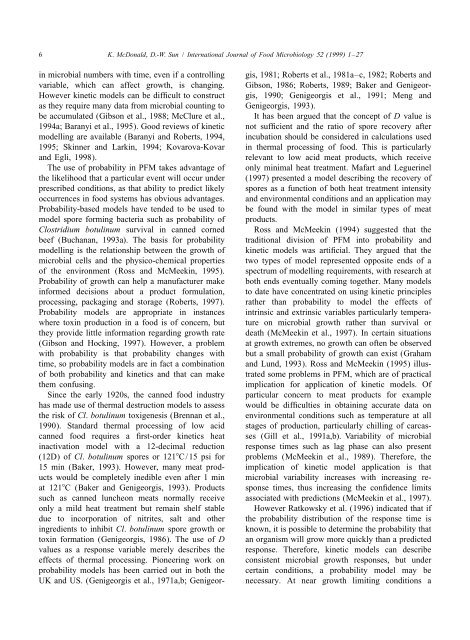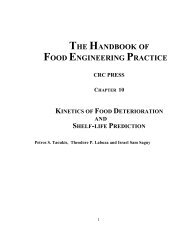Predictive food microbiology for the meat industry: a review
Predictive food microbiology for the meat industry: a review
Predictive food microbiology for the meat industry: a review
You also want an ePaper? Increase the reach of your titles
YUMPU automatically turns print PDFs into web optimized ePapers that Google loves.
6 K. McDonald, D.-W. Sun / International Journal of Food Microbiology 52 (1999) 1 –27<br />
in microbial numbers with time, even if a controlling gis, 1981; Roberts et al., 1981a–c, 1982; Roberts and<br />
variable, which can affect growth, is changing. Gibson, 1986; Roberts, 1989; Baker and Genigeor-<br />
However kinetic models can be difficult to construct gis, 1990; Genigeorgis et al., 1991; Meng and<br />
as <strong>the</strong>y require many data from microbial counting to Genigeorgis, 1993).<br />
be accumulated (Gibson et al., 1988; McClure et al., It has been argued that <strong>the</strong> concept of D value is<br />
1994a; Baranyi et al., 1995). Good <strong>review</strong>s of kinetic not sufficient and <strong>the</strong> ratio of spore recovery after<br />
modelling are available (Baranyi and Roberts, 1994, incubation should be considered in calculations used<br />
1995; Skinner and Larkin, 1994; Kovarova-Kovar in <strong>the</strong>rmal processing of <strong>food</strong>. This is particularly<br />
and Egli, 1998).<br />
relevant to low acid <strong>meat</strong> products, which receive<br />
The use of probability in PFM takes advantage of only minimal heat treatment. Mafart and Leguerinel<br />
<strong>the</strong> likelihood that a particular event will occur under (1997) presented a model describing <strong>the</strong> recovery of<br />
prescribed conditions, as that ability to predict likely spores as a function of both heat treatment intensity<br />
occurrences in <strong>food</strong> systems has obvious advantages. and environmental conditions and an application may<br />
Probability-based models have tended to be used to be found with <strong>the</strong> model in similar types of <strong>meat</strong><br />
model spore <strong>for</strong>ming bacteria such as probability of products.<br />
Clostridium botulinum survival in canned corned Ross and McMeekin (1994) suggested that <strong>the</strong><br />
beef (Buchanan, 1993a). The basis <strong>for</strong> probability traditional division of PFM into probability and<br />
modelling is <strong>the</strong> relationship between <strong>the</strong> growth of kinetic models was artificial. They argued that <strong>the</strong><br />
microbial cells and <strong>the</strong> physico-chemical properties two types of model represented opposite ends of a<br />
of <strong>the</strong> environment (Ross and McMeekin, 1995). spectrum of modelling requirements, with research at<br />
Probability of growth can help a manufacturer make both ends eventually coming toge<strong>the</strong>r. Many models<br />
in<strong>for</strong>med decisions about a product <strong>for</strong>mulation, to date have concentrated on using kinetic principles<br />
processing, packaging and storage (Roberts, 1997). ra<strong>the</strong>r than probability to model <strong>the</strong> effects of<br />
Probability models are appropriate in instances intrinsic and extrinsic variables particularly temperawhere<br />
toxin production in a <strong>food</strong> is of concern, but ture on microbial growth ra<strong>the</strong>r than survival or<br />
<strong>the</strong>y provide little in<strong>for</strong>mation regarding growth rate death (McMeekin et al., 1997). In certain situations<br />
(Gibson and Hocking, 1997). However, a problem at growth extremes, no growth can often be observed<br />
with probability is that probability changes with but a small probability of growth can exist (Graham<br />
time, so probability models are in fact a combination and Lund, 1993). Ross and McMeekin (1995) illusof<br />
both probability and kinetics and that can make trated some problems in PFM, which are of practical<br />
<strong>the</strong>m confusing.<br />
implication <strong>for</strong> application of kinetic models. Of<br />
Since <strong>the</strong> early 1920s, <strong>the</strong> canned <strong>food</strong> <strong>industry</strong> particular concern to <strong>meat</strong> products <strong>for</strong> example<br />
has made use of <strong>the</strong>rmal destruction models to assess would be difficulties in obtaining accurate data on<br />
<strong>the</strong> risk of Cl. botulinum toxigenesis (Brennan et al., environmental conditions such as temperature at all<br />
1990). Standard <strong>the</strong>rmal processing of low acid stages of production, particularly chilling of carcascanned<br />
<strong>food</strong> requires a first-order kinetics heat ses (Gill et al., 1991a,b). Variability of microbial<br />
inactivation model with a 12-decimal reduction response times such as lag phase can also present<br />
(12D) of Cl. botulinum spores or 1218C/15 psi <strong>for</strong> problems (McMeekin et al., 1989). There<strong>for</strong>e, <strong>the</strong><br />
15 min (Baker, 1993). However, many <strong>meat</strong> prod- implication of kinetic model application is that<br />
ucts would be completely inedible even after 1 min microbial variability increases with increasing reat<br />
1218C (Baker and Genigeorgis, 1993). Products sponse times, thus increasing <strong>the</strong> confidence limits<br />
such as canned luncheon <strong>meat</strong>s normally receive associated with predictions (McMeekin et al., 1997).<br />
only a mild heat treatment but remain shelf stable However Ratkowsky et al. (1996) indicated that if<br />
due to incorporation of nitrites, salt and o<strong>the</strong>r <strong>the</strong> probability distribution of <strong>the</strong> response time is<br />
ingredients to inhibit Cl. botulinum spore growth or known, it is possible to determine <strong>the</strong> probability that<br />
toxin <strong>for</strong>mation (Genigeorgis, 1986). The use of D an organism will grow more quickly than a predicted<br />
values as a response variable merely describes <strong>the</strong> response. There<strong>for</strong>e, kinetic models can describe<br />
effects of <strong>the</strong>rmal processing. Pioneering work on consistent microbial growth responses, but under<br />
probability models has been carried out in both <strong>the</strong> certain conditions, a probability model may be<br />
UK and US. (Genigeorgis et al., 1971a,b; Genigeor- necessary. At near growth limiting conditions a














